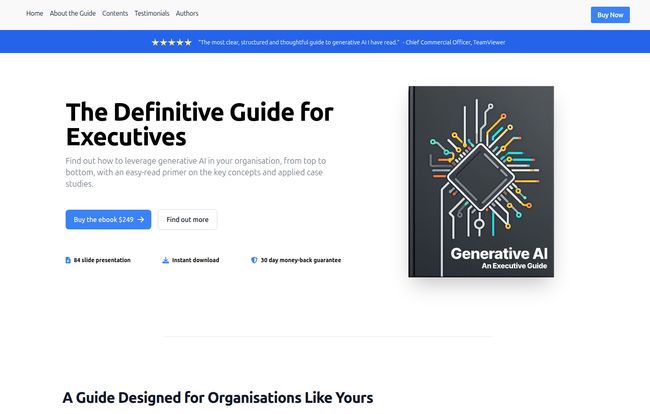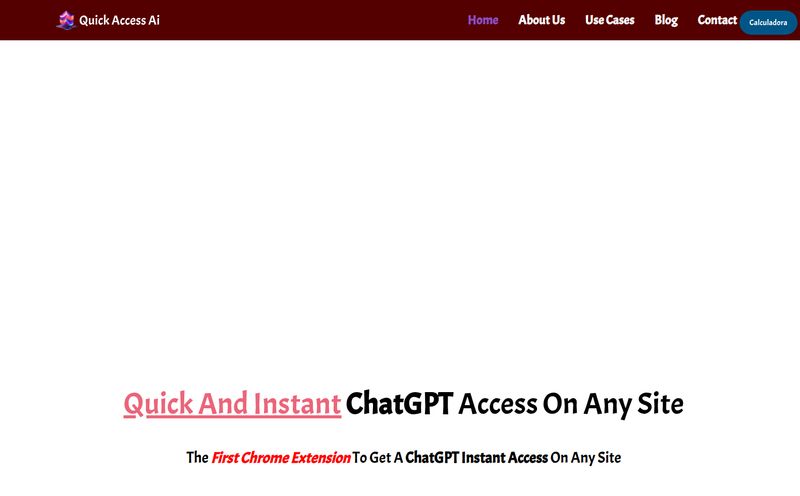The firehose of information about Generative AI is officially overwhelming. Every day, there's a new model, a new 'game-changing' application, and a dozen new acronyms to learn. As someone who's spent years navigating the hype cycles of SEO and CPC advertising, this feels familiar. But also… different. The scale is just immense.
If you're in a leadership position, you’re likely feeling the pressure. You know you need an AI strategy, but where do you even begin? Most of what's out there is either hyper-technical jargon meant for engineers or vague, fluffy articles that say 'AI is the future!' without telling you a single practical thing to do on Monday morning. It's frustrating.
So, when a resource called 'Generative AI: An Executive Guide' from ExecutiveGuide.ai landed on my radar, my curiosity was piqued. It claims to be a definitive guide for executives. A big claim. I've seen a lot of guides in my time, and most of them are… well, let's just say they make good doorstops. But this one seemed different. Let’s see if it holds up.
So What Exactly is This Executive AI Guide?
In short, it’s an 84-slide presentation in PDF format designed to be a primer and a playbook. It’s not trying to teach you Python; it’s trying to teach you how to apply Large Language Models (LLMs) like GPT-4 to actually create value in your company. It’s for the decision-makers, the people who need to understand the 'what' and 'why' before they task their teams with the 'how'.
What caught my eye immediately were the authors, Sam Gilbert and Ankur Shah. These aren't just random content marketers. Sam is a researcher at the Bennett Institute for Public Policy at Cambridge. Ankur founded the Facebook AI content team and has deep experience in the startup world. Their work has been featured in places like the Financial Times and the BBC. That’s a decent bit of credibility right out of the gate. It tells me this is likely grounded in real-world application, not just theory.
Cutting Through the Noise Why a Guide Like This Matters
The biggest challenge with new technology isn't the tech itself. It’s the change management. It's getting buy-in. It's avoiding the expensive pilot projects that go nowhere. I’ve seen companies spend fortunes on martech tools that just gather digital dust because nobody knew how to properly integrate them into the workflow.
AI is that on steroids. Having a powerful LLM is like being handed the keys to a Formula 1 car. Amazing, but if you don’t know how to drive, you're more likely to end up in a wall than on the podium. This guide aims to be the driver's manual for the C-suite.
It’s about bridging that massive gap between seeing a cool AI demo on X (formerly Twitter) and actually deploying a solution that improves productivity or creates a new revenue stream. That's a chasm many businesses are staring into right now.
A Look Inside The Executive Guide Playbook
Okay, so what do you get for your money? It's more than just a few slides with buzzwords. The guide is structured to give you a comprehensive but speedy onboarding.
It starts with a Market Overview to get you grounded in the current landscape—who the big players are, what the market dynamics look like. Then it moves into the good stuff: real, practical Use-Cases and industry-specific Case Studies. This is the part I always look for. Theory is fine, but I want to see how a company like Sony or Unilever (both of whom the authors have worked with) might approach this. It also includes handy Cheat-Sheets, which are perfect for getting the key concepts to stick without needing to memorize everything.
Crucially, it covers Change Management and provides an Action Plan with questions to pose to your team. To me, this is maybe the most valuable part. It’s not just information; it’s a prompt for action. It’s designed to kickstart the exact conversations that need to happen inside an organization.

Visit ExecutiveGuide.ai
What I Genuinely Like About This Approach
First off, it’s short. They claim it’s a 30-minute read. Hallelujah. In a world where my 'to-read' list is a source of constant, low-grade anxiety, a resource that respects my time gets a huge checkmark. Executives dont have time for a 400-page textbook on tokenization.
Second, it's practical. The focus on real-world examples, action plans, and key questions makes it immediately useful. It’s built for application, not just for thought leadership brownie points.
And honestly, the 30-day money-back guarantee is a big deal. It shows a level of confidence in the product that I appreciate. It takes the risk out of the purchase. If it's just a rehash of stuff you've already read, you can get your money back. Simple as that.
Let's Be Real What Are The Downsides?
Okay, nothing's perfect. And for the sake of a balanced review, let's talk about the potential drawbacks.
The most obvious one is the price. At $249, it's not an impulse buy for a PDF. You have to see it as an investment. How much does one bad decision in your AI strategy cost? How much is an hour of a top-tier consultant's time? When you frame it that way, the price starts to look a lot more reasonable. But still, it's a price point that will make some people pause.
Next is the format. It's an 84-slide PDF presentation. If you're someone who loves the feel of a physical book or the reflowable text of a Kindle e-book, this might not be your prefered format. It's designed to be scanned and digested quickly, like a briefing document, which fits the target audience, but it's a specific format.
Finally, it's an executive guide. It's not going to walk your data scientists through the finer points of model training. It operates at a strategic level, so if you're looking for deep technical implementation details, you'll need to look elsewhere. And that’s the point.
The All-Important Question How Much Does It Cost?
Let's just lay it out clearly. No beating around the bush.
| Plan | Price | What You Get |
|---|---|---|
| Ebook | $249 +VAT | Instant access to the 84-slide presentation in PDF format. |
You pay once, and you get instant access. It’s straightforward, which is something I can always get behind.
My Final Verdict Is This AI Guide for You?
So, who should buy this? In my professional opinion, this is tailor-made for a very specific person: the time-poor, information-overloaded executive, founder, or senior manager. It's for the person who needs to lead their organization's response to AI but doesn't have the time or technical background to sift through thousands of articles and whitepapers. It's a shortcut through the jungle.
Who is it not for? ML engineers, data scientists, or anyone looking for hands-on coding tutorials. This is a strategy document, not a technical manual.
Ultimately, it looks like a solid, well-researched, and intelligently targeted resource. It seems to understand its audience perfectly and delivers exactly what it promises: a concise, actionable guide to help leaders make sense of generative AI and start applying it to their business. It might just be the tool that helps you move from 'we should look into AI' to 'here is our AI plan for the next quarter'.
Frequently Asked Questions
- Is this guide suitable for non-technical people?
- Absolutely. It was specifically designed for a non-technical audience like executives, managers, and entrepreneurs. The testimonials even praise how clear and accessible it is.
- Is there really a money-back guarantee?
- Yes, there is a 30-day money-back guarantee. If you don't find it valuable, you can request a refund, which significantly lowers the risk of purchase.
- How long does the guide take to get through?
- It's designed to be a quick read, estimated at around 30 minutes. The goal is to deliver high-impact information efficiently.
- Will this guide teach me how to code or build AI models?
- No. This is a strategic guide. It focuses on the business aspects: what generative AI is, what the market looks like, how to find use cases, and how to create an action plan for your organization. It's about strategy, not programming.
- Is $249 a fair price for a PDF?
- Value is subjective, but consider the alternative. The cost of a few hours of a specialized consultant's time or the cost of a misstep in your AI strategy would be significantly higher. The price reflects the curated, high-level strategic insights it provides.
Final Thoughts
Navigating the AI revolution doesn't have to be a shot in the dark. While the hype is loud, the real opportunity lies in quiet, informed, strategic action. Tools like the 'Generative AI: An Executive Guide' are valuable because they offer a clear map and a compass, helping leaders steer their companies toward genuine innovation instead of just chasing the next shiny object. And in today's market, that clarity is worth its weight in gold.



